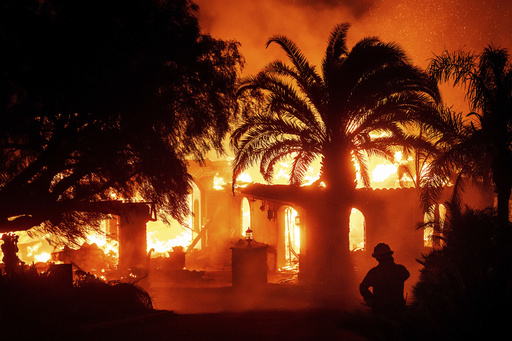
Camarillo, California – A rapidly spreading wildfire, known as the Mountain Fire, continued to wreak havoc northwest of Los Angeles for a second consecutive day on Thursday. The fire, exacerbated by strong winds, has already destroyed numerous homes and prompted mass evacuations as it swelled in size within mere hours.
Officials reported that evacuation orders were issued for over 10,000 residents as the fire threatened around 3,500 structures in suburban areas, agricultural lands, and ranches, according to California Governor Gavin Newsom. Late Wednesday, the Ventura County Fire Department indicated that the fire was not contained at all.
The National Weather Service issued a red flag warning, signaling high fire danger conditions, which would remain in effect until Thursday evening. However, they anticipated a significant reduction in wind speeds by Thursday night, providing some hope for containment efforts.
In light of the ongoing Santa Ana wind conditions, officials encouraged vigilance among residents across several Southern California counties. Furthermore, they warned about potential power outages and the risk of downed trees due to the intense winds.
This particular fire erupted in an area historically prone to devastating wildfires, resulting in thick plumes of smoke that obscured visibility for both firefighters and evacuees. The Mountain Fire escalated from less than half a square mile to over 16 square miles in a matter of just five hours.
First responders were proactive in their evacuation efforts, reaching out to approximately 14,000 residents to advise them to leave the area as embers spread and ignited new fires. Ventura County Fire Captain Trevor Johnson described the frantic scene as crews rushed to homes in danger. He stated, “This is as intense as it gets. The hair on the back of the firefighters’ neck I’m sure was standing up,” conveying the urgency and danger faced by the firefighting teams.
Reports indicated that two individuals were hospitalized for smoke inhalation, but thankfully, no significant injuries were reported among the firefighters. Fire officials continued to deploy a range of resources, including helicopters and fixed-wing aircraft to dispense water and fire retardant, yet the blaze remained unruly. Spokesperson Andrew Dowd noted that details regarding the extent of structural damage were still pending.
In a separate incident to the south, crews from the Los Angeles County Fire Department worked desperately to manage a wildfire near Malibu’s Broad Beach. Prompted by the threat to high-value properties, authorities temporarily closed the Pacific Coast Highway. Residents around the area were advised to shelter in place while aerial units fought the flames, which had engulfed about 50 acres. By late Wednesday, the Broad Fire was 60% contained, and fire officials confirmed the fire had destroyed two structures.
As gusty winds reached speeds up to 50 mph and humidity levels dropped to as low as 9%, conditions throughout Southern California remained volatile for extreme fire behaviors. Wind gusts surpassed 61 mph on Wednesday, further complicating firefighting efforts.
Forecasters extended the red flag warnings from the central coast all the way to the San Francisco Bay Area and surrounding northern counties, anticipating strong winds in those regions as well.
In response to the extreme fire hazard stemming from strong winds, California utilities began shutting down electrical systems proactively. This precaution came after a series of large, deadly wildfires linked to utility equipment in recent years. By Wednesday, over 65,000 customers in Southern California experienced power cuts, alongside more than 20,000 impacted in Northern California.
These wildfire events were occurring in regions that had suffered from prior destructive fires, such as the 2018 Woolsey Fire, which resulted in three fatalities and the loss of 1,600 homes near Los Angeles and the 2017 Thomas Fire, which devastated over a thousand homes in Ventura and Santa Barbara counties. Southern California Edison, the utility company involved, has faced significant financial liability following the assertion that their equipment had ignited both of these catastrophic fires.
